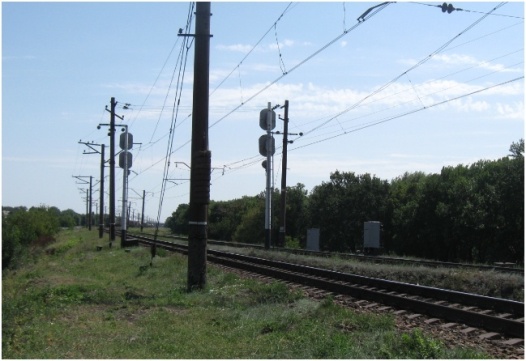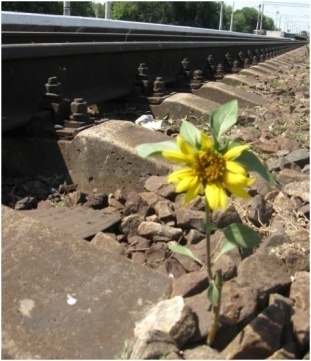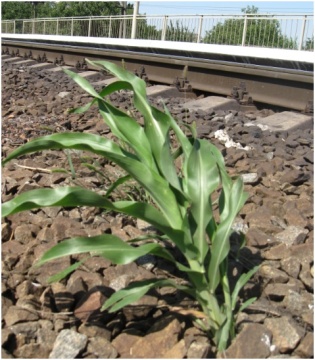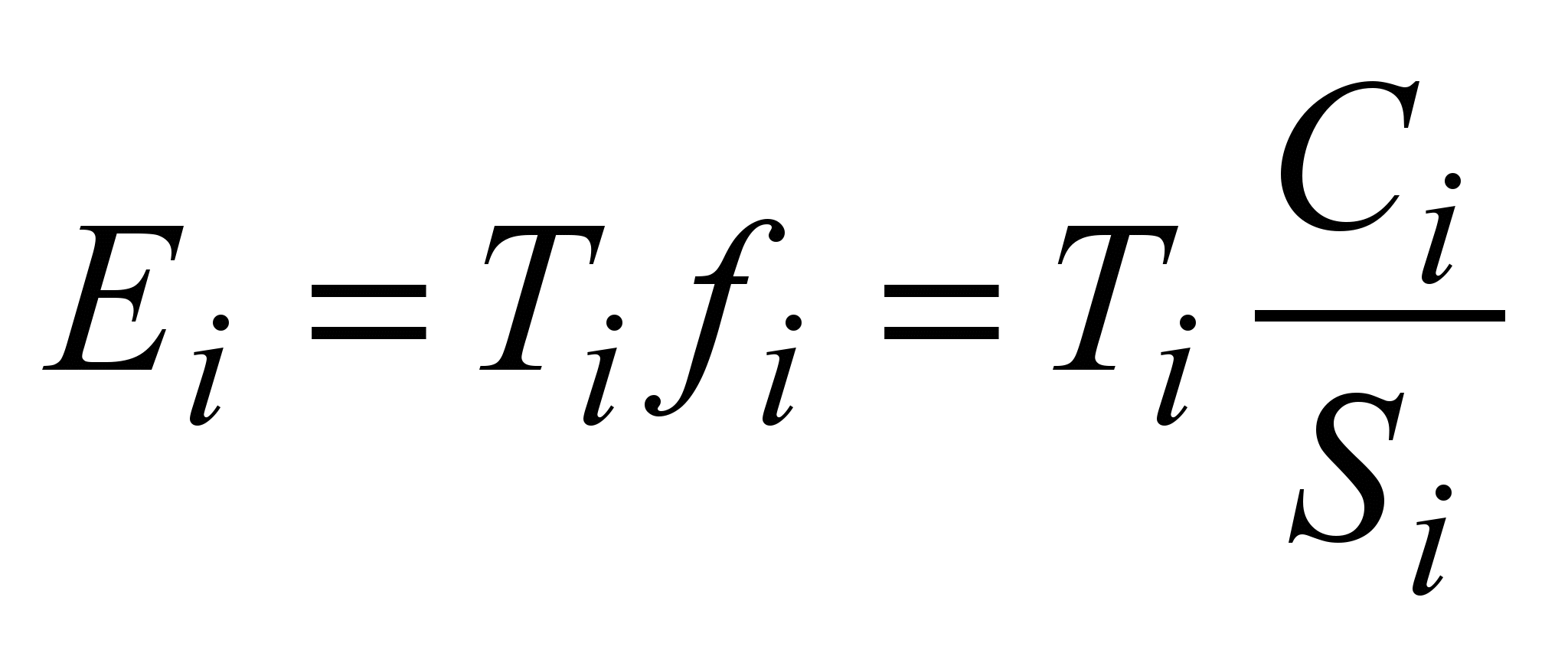ISSN
2307–3489 (Print), ІSSN
2307–6666
(Online)
Наука
та прогрес транспорту. Вісник
Дніпропетровського
національного університету залізничного
транспорту, 2018, № 4
(76)
Екологія
на транспорті
UDC
656.2:504
А.
V. Samarska1*,
Y. V. Zelenko2
1*Dep.
«Chemistry and Engineering Ecology», Dnipropetrovsk National
University of Railway Transport named after Academician V. Lazaryan,
Lazaryan St., 2, Dnipro, Ukraine, 49010, tel. +38
(097) 091 74 51,
e-mail samarskaya.av@gmail.com,
ORCID 0000-0002-0828-9457
2
Dep.
«Chemistry and Engineering Ecology», Dnipropetrovsk National
University of Railway Transport named after Academician V. Lazaryan,
Lazaryan St., 2, Dnipro, Ukraine, 49010, tel. +38
(067) 774 04 64,
e-mail j.v.zelenko@gmail.com,
ORCID 0000-0001-5551-0305
assesment of The
railway influence on The Heavy
MetAl accumulation in SOIL
Purpose.
The scientific paper aims at analyzing the current state of the
railway infrastructure soil contamination with heavy metals (HM),
namely, the three stations of Prydniprovska railway:
Kamianske-Pasazhyrske, Zaporizhzhia-Kamianske and Trytuzna.
Methodology. The
research object is the soil of the above mentioned railway stations,
the research subject is the total content of HM. Sampling was carried
out every 15 m between and outside both rails up to the end of
railway ties. The total area of the investigated sites is 600 m2.
The total form of Fe, Pb, Zn, Cu, Ni, Cd and Mn concentration was
determined by the atomic absorption spectrometry method. The obtained
data were compared with the background concentration of HM for
Dnipropetrovsk oblast and the results of analyzing the reference
control located at a distance of 250 m from the railway stations.
Findings.
It is found out that rail transport is a source of HM emission into
soil. The findings indicate that the soil state of the
Kamianske-Pasazhyrske station corresponds to a low ecological risk
and a low degree of pollution, since the station is a passenger one
only and pollution occurs mostly due to and
that of the pantograph and overhead system, as well as the pesticide
use. The soil contamination of the Zaporizhzhia-Kamianske
station is characterized by a considerable potential environmental
risk and a very high degree of pollution. This station is a
cargo-passenger one, and this pollution level is mainly due to
loading and unloading processes. The soil of the Trytuzna station is
characterized by an average potential ecological risk and a moderate
degree of pollution. Although this station is mainly used for the
freight trains reformation, but due to the transportation of large
volumes of bulk ore cargoes HM fall into soil. Besides, the station
is not electrified. Recommendations for assessment of the soil
pollution levels are given. Originality.
For the first time the potential ecological risk of soil
contamination was determined on the basis of the physical and
chemical analysis of the HM content in the soil of the
above-mentioned stations. Practical
value. The results of the study can
be used as a justification of the reasonability of introducing the
environmental monitoring programs for the railway land, the
environmental protection measures for the soil treatment from HM,
correcting the railway exclusion zone, as well as protection of
adjacent territories from the propagation and accumulation of the
mentioned pollutants. The necessity and urgency of the constant
control of the HM content in the railway soil and the relevance of
the research continuation in this scientific direction are confirmed
on the basis of the received data.
Keywords:
heavy metals; railway transport; soil, railway stations, potential
environmental risk
Introduction
Rail
transport operation has a negative influence on the environmental
quality. This influence can be seen in the environmental
contamination with both organic (oil products, polycyclic aromatic
hydrocarbons, polychlorinated biphenyls), and inorganic substances
(heavy metals, SO2,
CO, CO2,
NO2,
etc.).
Studies
devoted to railway transport as a factor of environmental pollution
confirm the hypothesis that this mode of transport can bring to soil
such persistent and dangerous pollutants as heavy metals
(hereinafter – HM) [1, 4-7, 10-14, 17-20].
HM
concentration in soil samples taken in the space between rails may
exceed the benchmarks ten times. For example, the study of Polish
scientists demonstrates the following HM concentration in the soil
of the Iława Główna railway junction, mg/kg: in the area of
sidings Pb – 4481/4942;
Cd − 5,41/5,12;
Cu –
1911/1612;
Zn – 12641/12232;
Hg – 0,5731/0,9692;
Fe − 448001/397002;
Co – 91/82;
Cr – 671/582;
Mo − 21/22
(1
– between rails, 2
– outside rails) [13]. The HM content indicators in three
re-ference
sites mg/kg: Pb – 1a/2b/3c;
Сd − n.d.a/n.d.b/n.d.c;
Cu – 4a/4b/4c;
Zn – 23a/23b/18c;
Hg – 0,014a/0,05b/0,013c;
Fe – 4400a/4500b/5000c;
Co – 1a/1b/2c;
Cr – 5a/6b/8c;
Mo – n.d.a/n.d.b/1c.
n.d. – not detected, a
– 500 m southwest from the railway junction, b
– 500 m to the southeast, c
– 2 km to the east [13].
The
obtained data demonstrate the significant content of iron, which is
natural for railway transport, lead, cadmium, copper and zinc, which
may indicate specificity of the cargoes transported, loaded and
unloaded at this station.
Another
study, conducted by Kajetan Dzierżanowski and Stanisław W.
Gawronski also confirms the assumption that railway transport plays
a significant part in the HM accumulation in soil and plants. The
study was conducted in
situ at
the Warsaw-Otwock railway connection using the X-ray fluorescent
spectrometer [11]. The authors compare the obtained results with the
permissible levels of HM concentration in the surface layer for
transport lands, mg/kg approved in Poland [11]. Table 1 presents the
results of Kajetan Dzierżanowski and Stanisław W. Gawronski`s
investigation and the permissible levels of HM concentration in
Poland, approved in 2002.
Table
1
HM
concentration in surface layer of
the Warsaw-Otwock railway
ground and permissible levels of HM concentration
|
HM
|
Concentration,
mg/kg
|
Standard
deviation, mg/kg
|
Permissible
concentration levels of HM
|
|
Ba
|
1092.1
|
299.1
|
1000
|
|
Cr
|
1108.4
|
331.4
|
500
|
|
Zn
|
142.4
|
17.7
|
1000
|
|
Cu
|
894.3
|
41.5
|
600
|
|
Mn
|
1528.9
|
160.9
|
–
|
|
Mo
|
18.0
|
4.0
|
250
|
|
Ni
|
588.1
|
101.1
|
300
|
|
Pb
|
65.0
|
8.3
|
600
|
|
Hg
|
25.3
|
6.0
|
30
|
|
Fe
|
196112.7
|
3909.8
|
–
|
The
presented data show the high content of such metals as barium,
chromium, copper, nickel, mercury and iron typical of railways. It
should be noted that it is difficult to assess the degree of the
railway operation influence on the HM accumulation without comparing
the obtained data with those at the referent sites or background
concentration. It can only be concluded that the approved standards
for Ba, Cr, Cu and Ni have been exceeded.
However,
the data on the HM accumulation in plants in the area adjacent to
the Warsaw-Otwock railway junction is of greater interest. For
example, Viola
arvensis
accumulates
approximately 230 mg/kg Zn, Vicia
cracca – ≈
30
mg/kg
Mo,
Cerastium
dubium
–
≈
160 mg/kg
Cu,
400
mg/kg
Mn, 8 mg/kg
Pb, 34000 mg/kg
Fe
[11].
This, in turn, confirms the railway transport influence on the HM
introduction and accumulation both in the soil of adjacent
territories and in plants that grow there.
According
to the results of chemical analysis of the soil samples from the
Białystok Fabryczny, Siemianówka and Waliły railway stations in
2015 [20], the pollution levels appear to be much lower than in
previous studies. However, the soil biotesting shows significant
toxicity of the soil of the Białystok Fabryczny and Siemianówka
stations [20]. The information is given in Table 2.
Table
2
Results
of chemical analysis of the soil samples
from the Białystok
Fabryczny, Siemianówka and Waliły railway stations
|
HM
|
Station
|
|
|
Białystok Fabryczny
|
Siemianówka
|
Waliły |
|
Zn
|
130
± 10.4
|
75
± 6.0
|
106
± 8.58
|
|
Cu
|
107
± 16.1
|
27
± 4.1
|
46
± 6.9
|
|
Pb
|
153
± 27.5
|
20
± 3.6
|
27
± 4.9
|
|
Ni
|
14
± 3.4
|
17
± 4.1
|
52
± 12.5
|
|
Hg
|
0.06
± 0.01
|
<0.05
|
<0.05
|
|
Cd
|
<0.70
|
<0.70
|
<0.70
|
|
Cr
|
25
± 5.3
|
15
± 3.2
|
70
± 14.7
|
It
is important the fact that at present in Ukraine there are no
legally approved permissible levels of HM concentration for
transport and communication lands, industry and urban territories.
As
for the HM sources at railway transport, they are, in the first
place, cargo transportation, its dispersing, scattering and spilling
on the track and adjacent territories [1, 5–7, 10–14, 19]. For
example, the total amount of losses during the transportation of
mineral fertilizers in bulk in covered cars is up to 8%, in gondola
cars up to 28%. When transported in multi-purpose cars annually up
to 7% of ore and 3% of cement are lost [7].
According
to the State Statistics Service of Ukraine [3], the railway
transport ranks first in terms of cargo transportation volumes. The
Tables 3 and 4 show the cargo turnover, volumes of cargo
transportation in 2017, and transportation of various types of cargo
by rail in 2017, respectively.
Other
sources of HM at railway transport:
– friction
in systems: wheel-brake blocks, wheel-rail, pantograph-contact wire,
bearings [5–7,
10–14, 18, 19];
– use
of herbicides [7, 13];
– coal
heating of cars [5–7];
– exhaust
gases of locomotive engines [5–7,
10, 12];
– migration
from wooden and ferro-concrete sleepers, from rubble and ballast
section materials [5–8,
10, 14];
– garbage
discarded from trains and on platforms.
Table
3
Cargo
turnover and volumes of cargo transportation in 2017
|
|
Cargo
turnover
|
Volume
of transported cargoes
|
|
|
mln.
tkm
|
in
% to 2016.
|
mln.t
|
in
% up 2016.
|
|
Transport
|
343057.1
|
105.8
|
635.9
|
101.8
|
|
railway
|
191914.1
|
102.3
|
339.5
|
98.9
|
|
automobile
|
41178.8
|
108.4
|
175.6
|
104.7
|
|
water
|
4257.1
|
106.3
|
5.9
|
88.1
|
|
pipeline
|
105434.4
|
111.7
|
114.8
|
107.6
|
|
air
|
272.7
|
120.5
|
0.1
|
110.5
|
Table
4
Cargo
transportation in 2017
|
|
Performed,
mln.t
|
In
% to 2016.
|
|
Transported
cargoes
|
339.5
|
98.9
|
|
dispatched
|
277.3
|
94.9
|
|
According
to freight nomenclature
|
|
|
|
coal
|
43.9
|
76.2
|
|
coke
|
5.0
|
70.8
|
|
oil
and petroleum products
|
3.8
|
115.3
|
|
iron
ore and manganese ore
|
64.9
|
93.5
|
|
ferrous
metals
|
20.8
|
82.4
|
|
ferrous
scrap
|
3.1
|
114.9
|
|
timber
cargo
|
2.8
|
66.8
|
|
chemical
and mineral fertilizers
|
3.5
|
84.2
|
|
grains
and grinding products
|
35.7
|
111.8
|
|
cement
|
5.9
|
101.0
|
|
construction
material
|
41.2
|
116.5
|
|
other
cargoes
|
46.7
|
118.0
|
Moreover,
the HM accumulation in soil during the railway operation is
influenced by a wide range of factors: intensity and speed of train
movement; age of the railway and degree of its operation; initial
braking speed, braking length; the nature and volumes of transported
cargoes; weather conditions; relief; granulometric and chemical
content of soil; vegetative cover.
Therefore,
the HM content in the railway infrastructure soil can differ
considerably and vary widely. Accordingly, the study of the railway
transport influence on the HM emission into the soil is an important
direction of scientific research.
Purpose
The
main purpose of the article is analyzing the current state of the
railway infrastructure soil contamination with HM; assessing
and
determining the rail transport share in the problem of the HM
accumulation in soil.
In
order to achieve the purpose, the following stages are realized:
literary review of the problem; analytical assessment of soil
contamination levels of railway stations with heavy metals;
calculations of total contamination and potential environmental
risks of soil contamination with HM; development of recommendations
for further monitoring the toxicological state of soil.
Methodology
The
research object is the soil of the three railway stations of
Prydniprovska
railway:
1) passenger
station – Kamianske-Pasazhyrske, year of opening 1965, electrified
(hereinafter – «KP» station);
2) freight-passenger
station − Zaporizhzhia-Kamianske,
year of opening 1884, electrified (hereinafter – «KZ» station);
3) freight
station – Trytuzna, year of opening 1884, non-electrified
(hereinafter station «Т»).
The
research subject is the total content of HM. Determining the total
forms are enough for the space between tracks, since the moving ones
play a minor role in this case, there is no migration in the
«soil-plant» and «soil-plant-man» chains.
The
sampling scheme is shown in Figure 1. Sampling
was
carried out every 15 m between (1)
and outside
both rails (2).
The weight of each sample is 250-300 g, the depth of sampling is
0-20 cm. The
total area of the investigated sites is 600 m2.
The principle of the sampling choice is determined by the fact that
the stations are surrounded by buildings and the HM distribution at
different distances cannot be assessed.
The
reference sites are at a distance 250 m from each station. The
sampling was carried out using the «envelope» method.
Figure
2 shows the places of the soil sampling. It was carried out at the
end of August 2017 in dry, hot weather.
The
HM concentration in station soil was determined by the
atomic-adsorption method. Total forms of HM were extracted with
nitric acid (1:1). The HM content in the studied soil samples was
calculated using the formula (1):

where
Х – is the mass fraction of the i-th metal, determined in the
air-dry soil sample, mg/kg; С1
– is the concentration of the i-th metal in the studied acid
extract of soil, found according to the calibration graph, mg/dm3;
С0
– is the concentration of the i-th metal in the control sample
found according to the calibration graph, mg/dm3;
V – is the volume of the investigated solution, cm3;
m – is the weight of the air-dry soil sample, g.

Fig.
1. The scheme of sampling at railway stations
1
– the area of sampling between rails, 2
– the area of sampling outside both rails



Fig.
2. The sampling sites at the station Kamianske-Pasazhyrske
In
order to assess the level of the HM accumulation in soil, we
calculated a total contamination index Zс,
which reflects the complex influence of the whole group of elements
and is determined as the additive sum of the excess of elements
concentration coefficient above the background level using formula 2
[2]:


 (2)
(2)
where
n – is the number of elements under consideration, Кс – is the
coefficient of concentration (accumulation), the ratio of actual
concentration to background content [2].
Although
this methodolgy is used in many works related to the assessment of
HM accumulation in soil, the disadvantage of the Zс
indicator is that it does not reflect the toxicity of each metal,
therefore, it is advisable to use such an indicator as RI
– potential environmental risk of soil contamination, which is
determined by the formula 3 [9, 15, 16]:
 (3)
(3)
where
Ei
– is a risk factor for the і
-th HM,
 (4)
(4)
where
Ті – is the factor reflecting the toxicity of the і-th HM and
the degree of environmental sensitivity to this metal, the values of
Ті
for Hg, Cd, As, Ni, Cu, Pb, Cr, Zn and Mn are 40, 30, 10, 5, 5, 5,
2, 1 and 1, respectively; fi
– is
the ratio of the actual concentration of HM, (Сі)
to its background content (Sі)
[9, 15, 16]. Classifications of Zc
and RI are presented in the Tables 5 and 6.
Table
5
Classification
of the total soil contamination
index Zс
|
Contamination
degree
|
Zс
|
|
very
low
|
<
8
|
|
low
|
8–16
|
|
moderate
|
16–32
|
|
high
|
32–64
|
|
very
high
|
64–128
|
|
extremely
high
|
>
128
|
Table
6
Classification
of potential ecological risk
of soil contamination
|
Ei
|
Individual
|
RI
|
General
|
|
Ei
≤40
|
Low
|
RI
≤150
|
Low
|
|
40<Ei≤80
|
Average
|
150<RI≤300
|
Average
|
|
80<Ei≤160
|
Significant
|
300<RI
≤600
|
Significant
|
|
160<Ei≤320
|
High
|
RI>600
|
Very
high
|
|
Ei>320
|
Extremely
high
|
|
|
Findings
The
research results are presented in Table 7. We determined the
concentration of total forms of Mn, Cu, Zn, Ni, Pb, Cd, and Fe in
the soil of «KP», «ZK», «T» stations and at the three
reference sites where the anthropogenic influence is quite
insignificant.
The
given data across the board exceed the reference indexes and the
background concentration, which shows the direct railway transport
influence on the HM accumulation in soil.
The
obtained results indicate that the soil state of the «KP» station
corresponds to a low ecological risk and a low degree of
contamination, since it is a passenger station only and pollution
occurs mostly due to the friction of wheels and rails, that of the
pantograph and contact wire, as well as the herbicide use.
The
soil contamination of the «ZK» station is characterized by a
significant potential environmental risk and a very high degree of
pollution. This station is a freight-passenger one and the pollution
level is mainly due to the loading and unloading processes.
The
soil of the «T» station is characterized by an average potential
environmental risk and a moderate degree of pollution. Although
this station is used for the freight trains reformation, but due to
transporting large volumes of bulk ore cargoes HM fall into the
station soil. Moreover, the station is not electrified.
Originality and practical
value
For
the first time the potential ecological risk of soil contamination
was determined on the basis of the physical-chemical analysis of the
HM content in the soil of the «KP», «ZK» and «T» stations. The
obtained data prove the necessity and urgency of constant monitoring
the HM content in the railway infrastructure soil.
The
results of the study can be used as a justification of the
reasonability of introducing the environmental monitoring programs
for the railway lands, the environmental protection measures for the
soil treatment from HM, protection
of the territories adjacent to railway from the propagation and
accumulation of the mentioned pollutants as well as correcting
the railway exclusion zone
Conclusions
Taking
into consideration the fact that the railway transport operation can
lead to the significant level of the soil contamination with HM,
which exceeds the regulatory one, it is necessary to develop
recommendations for non-purpose (agricultural) use of land sites
within the damping zone of railways.
According
to the presented data, differentiating the railway mainline zones
with high pollution indicators was carried out and the
recommendations on the measures for decontamination and
detoxification of the railway infrastructure soil were developed.
We
recommend to calculate the Zc
and RI indices for assessing the levels of soil contamination, as
well as to determine the HM concentration at the reference sites,
since the use of background concentration for comparison generates
many questions and concerns, although it is used by many
researchers. And as a final stage of assessment we suggest carrying
out biotesting, which demonstrates the toxic influence (or its
absence) of the investigated soil on plants, crustaceans, bacteria
and other living organisms.
Table
7
General
indicator of contamination and the potential ecological risk of
stations soil pollution
|
Stations
and
indicators according to the methodology
|
Heavy
metal concentration, mg/kg
|
|
Mn
(600*)
|
Cu
(20*)
|
Zn
(30*)
|
Ni
(10*)
|
Pb
(10*)
|
Cd
(1*)
|
Fe
(22 000*)
|
|
1
|
2
|
1
|
2
|
1
|
2
|
1
|
2
|
1
|
2
|
1
|
2
|
1
|
2
|
|
«KP»
|
654
|
670
|
61
|
60
|
178
|
170
|
32
|
31
|
40
|
35
|
1.5
|
1.5
|
35 670
|
35 660
|
|
Кс
|
1.1
|
1.1
|
3.1
|
3.0
|
5.9
|
5.7
|
3.2
|
3.2
|
4.0
|
3,5
|
1.5
|
1.5
|
1,6
|
1.6
|
|
Ei
|
1.1
|
1.1
|
15.2
|
15
|
5.9
|
5.7
|
16
|
16
|
20
|
17.5
|
45
|
45
|
1.6
|
1.6
|
|
RI
|
103.35
– low potential ecological risk
|
|
Zс
|
14
– low contamination degree
|
Continuation
of a table
7
General
indicator of contamination and the potential ecological risk of
stations soil pollution
|
Stations
and
indicators according to the methodology
|
Heavy
metal concentration, mg/kg
|
|
Mn
(600*)
|
Cu
(20*)
|
Zn
(30*)
|
Ni
(10*)
|
Pb
(10*)
|
Cd
(1*)
|
Fe
(22 000*)
|
|
1
|
2
|
1
|
2
|
1
|
2
|
1
|
2
|
1
|
2
|
1
|
2
|
1
|
2
|
|
«ZK»
|
2220
|
2220
|
456
|
476
|
678
|
656
|
111
|
115
|
340
|
324
|
4
|
4
|
61 860
|
61 230
|
|
Кс
|
3.7
|
3.7
|
22.8
|
23.8
|
22.6
|
21.8
|
11.1
|
11.5
|
34
|
32.4
|
4
|
4
|
2.8
|
2.8
|
|
Ei
|
3.7
|
3.7
|
114
|
119
|
22.6
|
21.8
|
55.5
|
57.5
|
170
|
162
|
120
|
120
|
2.8
|
2.8
|
|
RI
|
487.7
– significant
potential ecological risk
|
|
Zс
|
94.5
– very high contamination degree
|
|
«Т»
|
710
|
715
|
75
|
67
|
180
|
179
|
63
|
65
|
150
|
130
|
2
|
2
|
48 700
|
48 705
|
|
Кс
|
1.18
|
1.19
|
3.75
|
3.35
|
6
|
6
|
6.3
|
6,5
|
15
|
13
|
2
|
2
|
2.2
|
2.2
|
|
Ei
|
1.18
|
1.19
|
18.8
|
16.8
|
6
|
6
|
31.5
|
32.5
|
75
|
65
|
60
|
60
|
2.2
|
2.2
|
|
RI
|
189.14
– average
potential ecological risk
|
|
Zс
|
29.3
– moderate contamination degree
|
|
Reference
sites
|
3401/2402/3003
|
61/52/63
|
231/302/403
|
71/62/73
|
101/82/53
|
0.51/0.32/n.d.3
|
23401/30782/14603
|
*
− background HM content in soil of Dnipropetrovsk oblast
1,
2, 3 – benchmarks of the HM content for the «KP», «ZK» and «Т»
stations, respectively.
List of reference links
Бобрик,
Н. Ю. Поширення та акумуляція важких
металів у ґрунтах призалізничних
територій / Н. Ю. Бобрик // Вісн.
Дніпропетр. ун-ту. Серія: Біологія.
Екологія. – 2015. – Вип. 23 (2). – С. 183–189.
doi:
10.15421/011526
Дабахов, М. В.
Тяжелые металлы: Экотоксикология и
проблемы нормирования
: монография /
М. В. Дабахов, Е. В. Дабахова,
В. И. Титова. – Нижний
Новгород
: ВВАГС,
2005. – 165
с.
Державна
служба статистики України [Electronic
resource]. – Available at: http://www.ukrstat.gov.ua/
– Title
from the screen. – Accessed : 23.07.2018.
Журавлева,
М. А. Загрязнение
придорожной зоны тяжелыми металлами
/
М. А. Журавлева, Н. И. Зубрев,
С. М. Кокин
// Мир транспорта.
– 2014. – Т.
12, №
6. –
С. 174–178.
Зеленько,
Ю. В. Проблема забруднення важкими
металами смуги відводу залізниць / Ю.
В. Зеленько, А. В. Самарська // Залізн.
трансп. України. – 2014. – № 5 (108). – С.
51–53.
Казанцева,
М. Ю. Железнодорожный транспорт как
источник загрязнения окружающей среды
/ М. Ю. Казанцева, Д. А. Зибарева //
Самарский научный вестник.
– 2014. –
№ 4 (9) – С. 54–56.
Казанцев,
И. В. Железнодорожный транспорт как
источник загрязнения почв тяжелыми
металлами / И. В. Казанцев
// Самарский научный вестник. – 2015. –
№ 2 (11). – С.
94–96.
Крошечкина, И. Ю.
Комплексная оценка
загрязнения балластного слоя
железнодорожного полотна / И. Ю. Крошечкина,
Н. И. Зубрев // XXI век: итоги прошлого
и проблемы настоящего плюс. –
2014. − №
1 (17). –
С. 100–102.
Assessing
heavy metal pollution in the surface soils of a region that had
undergone three decades of intense industrialization and
urbanization / Y. Hu, X. Liu, J. Bai, K. Shih, E. Y. Zeng, H. Cheng
// Environmental Science and Pollution Research. – 2013. – Vol.
20. – Iss.
9. – P.
6150–6159. doi: 10.1007/s11356-013-1668-z
Does
the Function of Railway Infrastructure Determine Qualitative and
Quantitative Composition of Contaminants (PAHs, Heavy Metals) in
Soil and Plant Biomass? / M. Mętrak, M.
Chmielewska,
B. Sudnik-Wójcikowska, B. Wiłkomirski, T. Staszewski, M.
Suska-Malawska // Water,
Air, & Soil Pollution.
– 2015. − Vol. 226. – Iss.
8. doi: 10.1007/s11270-015-2516-1
Dzierżanowski,
K.
Heavy metal
concentration in plants growing
on the
vicinity of railroad tracks: a pilot study / K.
Dzierżanowski,
S.
W.
Gawroński
// Challenges of Modern Technology. – 2012. –
Vol. 3, No.
1. –
P.
42–45.
Railway
Tracks − Habitat Conditions, Contamination, Floristic Settlement
− A Review / B. Wiłkomirski, H.
Galera, B. Sudnik-Wójcikowska, T. Staszewski, M. Malawska //
Environment and Natural Resources Research. – 2012. –
Vol. 2, No.
1. –
P. 86–95.
doi:
10.5539/enrr.v2n1p86
Railway
transportation as a serious source of organic and inorganic
pollution / B. Wiłkomirski, B. Sudnik-Wójcikowska, H. Galera, M.
Wierzbicka, M. Malawska // Water,
Air, & Soil Pollution.
– 2010. –
Vol. 218.
– Iss.
1-4. –
P. 333–345. doi: 10.1007/s11270-010-0645-0
Soil
and plants contamination with selected heavy metals in the area of
a railway junction / T. Staszewski, M.
Malawska, B. Studnik-Wójcikowska, H. Galera, B. Wiłkomirski
// Archives of Environmental Protection. – 2015. –
Vol. 41,
No. 1.
– Р.
35–42. doi: 10.1515/aep-2015-0005
Soil
Heavy Metal Pollution and Risk Assessment in Shenyang Industrial
District, Northeast China / X. Jiao, Y. Teng, Y. Zhan, J. Wu,
X. Lin // Plos One. – 2015. –
Vol. 10. –
Iss.
5. – P. e0127736.
doi:
10.1371/journal.pone.0127736
Soliman,
N. F. Potential ecological risk of heavy metals in sediments from
the Mediterranean coast, Egypt / N. F. Soliman, S. M. Nasr, M.
A. Okbah //
Journal of
Environmental Health Science and Engineering. – 2015. − Vol.
13. – Iss.
1. doi:
10.1186/s40201-015-0223-x
The
effects of railway transportation on the enrichment of heavy metals
in the artificial soil on railway cut slopes / Z. Chen, K. Wang, Y.
W. Ai, W. Li, H. Gao, C. Fang // Environmental
Monitoring and Assessment.
–
2013. –
Vol. 186.
– Iss.
2.
– P. 1039−1049.
doi: 10.1007/s10661-013-3437-3
The
effects of the Qinghai–Tibet railway on heavy metals enrichment
in soils
/ H. Zhang,
Z. Wang, Y. Zhang,
Z. Hu
// Science of the Total Environment. – 2012. –
Vol. 439. −
P. 240–248.
doi:
10.1016/j.scitotenv.2012.09.027
The
selected trace elements in soil
of railway stations in north-eastern Poland / B. Wiłkomirski, M.
Suska-Malawska, B. Sudnik-Wójcikowska, T. Staszewski // Rocznik
Świętokrzyski. Ser. B – Nauki Przyr. – 2013. – T. 34. −
P. 171–180.
Wierzbicka,
M. Multidimensional evaluation of soil pollution from railway
tracks / M. Wierzbicka, O. Bemowska-Kałabun, B. Gworek //
Ecotoxicology. – 2015. – Vol. 24.
– Iss.
4.
– P.
805–822.
doi:
10.1007/s10646-015-1426-8
А.
В. Самарська1*,
Ю. В. Зеленько2
1*Каф.
«Хімія та інженерна екологія»,
Дніпропетровський національний
університет залізничного транспорту
імені академіка В. Лазаряна, вул.
Лазаряна, 2, Дніпро, Україна, 49010, тел.
+38 (097) 091 74 51,
ел. пошта samarskaya.av@gmail.com,
ORCID 0000-0002-0828-9457
2Каф.
«Хімія та інженерна екологія»,
Дніпропетровський національний
університет залізничного транспорту
імені академіка В. Лазаряна, вул.
Лазаряна, 2, Дніпро, Україна, 49010, тел.
+38 (067) 774 04 64,
ел. пошта j.v.zelenko@gmail.com, ORCID
0000-0001-5551-0305
Оцінка
впливу залізничного транспорту на
накопичення важких металів у ґрунтах
Мета.
Наукова стаття має
за мету аналіз сучасного стану забруднення
важкими металами (ВМ) ґрунтів залізничної
інфраструктури, а саме трьох станцій
Придніпровської залізниці:
Кам’янське–Пасажирське, Запоріжжя–Кам’янське
й Тритузна. Методика.
Об’єкт дослідження – ґрунти вищезазначених
залізничних станцій, предмет – валовий
вміст ВМ. Відбір проб здійснювався
кожні 15 м між рейками та поза ними з
обох сторін. Загальна площа досліджуваних
територій – 600 м2.
Методом атомно-абсорбційної спектрометрії
визначено концентрації валових форм
Fe, Pb, Zn, Cu, Ni, Cd та Mn. Отримані дані
порівнювались із фоновими концентраціями
ВМ для Дніпропетровської області та з
результатами аналізу контрольних
ділянок, що знаходились на відстані
250 м від залізничних станцій. Результати.
Встановлено, що залізничний транспорт
є джерелом надходження ВМ у ґрунти.
Отримані результати вказують на те, що
стан ґрунтів станції Кам’янське–Пасажирське
відповідає низькому екологічному
ризику й слабкому ступеню забруднення,
оскільки станція є тільки пасажирською,
і забруднення відбувається за рахунок
тертя коліс та рейок, пантографа об
контактну мережу, а також використання
пестицидів. Забруднення ґрунтів станції
Запоріжжя–Кам’янське відрізняється
значним потенційним екологічним ризиком
і дуже сильним ступенем забруднення.
Ця станція є вантажно-пасажирською, і
такий рівень забруднення є здебільшого
наслідком процесів завантаження й
розвантаження. Ґрунти станції Тритузна
характеризуються середнім потенційним
екологічним ризиком та помірним ступенем
забруднення. На цій станції відбувається
переформування товарних поїздів, але
за рахунок перевезення значних обсягів
сипучих рудних вантажів у ґрунти станції
потрапляють ВМ. Крім того, станція
неелектрифікована. Надано рекомендації
щодо оцінки рівнів забруднення ґрунтів.
Наукова новизна.
Вперше на базі проведеного фізико-хімічного
аналізу вмісту ВМ ґрунтах вищезазначених
станцій визначено потенційний екологічний
ризик забруднення ґрунтів. Практична
значимість. Результати
дослідження можуть бути використані
як обґрунтування доцільності впровадження
програм екологічного моніторингу для
земель залізничного транспорту,
природоохоронних заходів із очищення
ґрунтів від ВМ, коригування зони
відчуження залізниць і захисту прилеглих
територій від розповсюдження та
акумуляції цих полютантів. На основі
отриманих даних доведена необхідність
постійного контролю вмісту ВМ у ґрунтах
залізничної інфраструктури й актуальність
продовження досліджень у даному
науковому напрямку.
Ключові
слова:
важкі метали; залізничний транспорт;
ґрунти; залізничні станції; потенційний
екологічний ризик
А.
В.
Самарська1*,
Ю.
В. Зеленько2
1*Каф.
«Химия и инженерная экология»,
Днепропетровский национальный
университет железнодорожного транспорта
имени академика В. Лазаряна, ул. Лазаряна,
2, Днипро, Украина, 49010, тел. +38 (097) 091 74 51,
эл. почта samarskaya.av@gmail.com,
ORCID 0000-0002-0828-9457
2Каф.
«Химия и инженерная экология»,
Днепропетровский национальный
университет железнодорожного транспорта
имени академика В. Лазаряна, ул. Лазаряна,
2, Днипро, Украина, 49010, тел. +38 (067) 774 04 64,
эл. почта j.v.zelenko@gmail.com, ORCID
0000-0001-5551-0305
ОЦЕНКА
ВЛИЯНИЯ ЖЕЛЕЗНОДОРОЖНОГО ТРАНСПОРТА
НА НАКОПЛЕНИЕ ТЯЖЕЛЫХ МЕТАЛЛОВ В грунтах
Цель.
Научная
статья своей целью имеет анализ
современного состояния загрязнения
грунтов железнодорожной инфраструктуры
тяжелыми металлами (ТМ), а именно трех
станций Приднепровской железной дороги:
Каменское–Пассажирское, Запорожье–Каменское
и Тритузная. Методика.
Объект исследования – грунты
вышеупомянутых железнодорожных станций,
предмет – валовое содержание ТМ. Отбор
проб осуществлялся каждые 15 м между
рельсами и за ними с обеих сторон. Общая
площадь исследуемых территорий − 600
м2.
Методом атомно-абсорбционной спектрометрии
определены валовые концентрации Fe, Pb,
Zn, Cu, Ni, Cd и Mn. Полученные данные сравнивались
с фоновыми концентрациями ТМ для
Днепропетровской области и результатами
анализа контрольных участков, находящихся
на расстоянии 250 м от железнодорожных
станций. Результаты.
Установлено, что железнодорожный
транспорт является источником поступления
ТМ в грунты. Полученные результаты
указывают на то, что состояние грунтов
станции Каменское–Пассажирское
соответствует низкому экологическому
риску и слабой степени загрязнения,
поскольку станция является только
пассажирской, и загрязнение происходит
за счет трения колес и рельсов, пантографа
о контактную сеть, а также использования
пестицидов. Загрязнение грунтов станции
Запорожье–Каменское отличается
значительным потенциальным экологическим
риском и очень сильной степенью
загрязнения. Эта станция является
грузопассажирской, и такой уровень
загрязнения является в большей степени
следствием процессов загрузки и
разгрузки. Грунты станции Тритузная
характеризуются средним потенциальным
экологическим риском и умеренной
степенью загрязнения. На этой станции
происходит переформирование товарных
поездов, но за счет перевозки значительных
объемов сыпучих рудных грузов в грунты
станции попадают ТМ. Кроме того, станция
неэлектрифицирована. Даны рекомендации
по оценке уровней загрязнения почв.
Научная
новизна.
Впервые на основе проведенного
физико-химического анализа содержания
ТМ в грунтах вышеупомянутых станций
определены потенциальные экологические
риски загрязнения грунтов. Практическая
значимость.
Результаты исследования могут быть
использованы в качестве обоснования
целесообразности внедрения программ
экологического мониторинга для земель
железнодорожного транспорта,
природоохранных мероприятий по очистке
грунтов от ТМ, корректировки зоны
отчуждения железных дорог и защиты
прилегающих территорий от распространения
и аккумуляции этих поллютантов. На
основе полученных данных доказана
необходимость постоянного контроля
содержания ТМ в грунтах железнодорожной
инфраструктуры и актуальность продолжения
исследований в данном научном направлении.
Ключевые
слова: тяжелые
металлы; железнодорожный транспорт;
грунты; железнодорожные станции;
потенциальный экологический риск
REFERENCES
Bobryk,
N. Y. (2015).
Spreading and accumulation of heavy metals in soils of railway-side
areas. Visnyk
of Dnipropetrovsk University. Biology, ekology,
23,
2,
183-189.
doi:
10.15421/011526 (in
Ukranian)
Dabakhov,
M. V., Dabakhova, E. V., & Titova, V. I. (2005). Tyazhelye
metally: Ekotoksikologiya i problemy normirovaniya: Monografiya.
Novgorod: VVAGS. (in
Russian)
Derzhavna
sluzhba statystyky Ukrainy.
Retrieved
from
http://www.ukrstat.gov.ua
(in
Ukranian)
Zhuravleva,
M. A., Zubrev, N. I., & Kokin, S. M. (2014).
Contamination of roadside areas with heavy metals. Worlds
of Transport and Transportation, 6,
174-181. (in
Russian)
Zelenko,
Y. V., & Samarska, A. V. (2014). Problema zabrudnennia vazhkymy
metalamy smuhy vidvodu zaliznyts. Zaliznychnyi
transport Ukrainy, 5(108), 51-53.
(in
Ukranian)
Kazantseva,
M. Y., & Zibareva, D. A. (2014). Rail
transport as a source of environmental pollution.
Samara
Journal of Science,
4(9),
54-56. (in
Russian)
Kazantsev,
I. V. (2015). Rail transport as a source of soil contamination with
heavy metals. Samara
Journal
of Science,
Journal
of Science,
2(11),
94-96. (in
Russian)
Kroshechkina,
I. Y., & Zubrev, N. I. (2014). Kompleksnaya
otsenka zagryazneniya ballastnogo sloya zheleznodorozhnogo polotna.
XXI vek:
itogi proshlogo i problemy nastoyashchego plyus,
1(17),
100-102. (in
Russian)
Hu,
Y., Liu, X., Bai, J., Shih, K., Zeng, E. Y., & Cheng, H.
(2013). Assessing heavy metal pollution in the surface soils of a
region that had undergone three decades of intense
industrialization and urbanization. Environmental
Science and Pollution Research,
20, 9,
6150-6159. doi: 10.1007/s11356-013-1668-z (in English)
Mętrak,
M.,
Chmielewska,
M.,
Sudnik-Wójcikowska,
B.,
Wiłkomirski,
B.,
Staszewski,
T., &
Suska-Malawska,
M.
(2015). Does
the Function of Railway Infrastructure Determine Qualitative and
Quantitative Composition of Contaminants (PAHs, Heavy Metals) in
Soil and Plant Biomass? Water,
Air, & Soil Pollution,
226,
8,
1-12.
doi:
10.1007/s11270-015-2516-1 (in English)
Dzierżanowski,
K.,
&
Gawroński,
S.
W.
(2013). Heavy
metal concentration in plants growing
on the
vicinity of railroad tracks: a pilot study. Challenges
of Modern Technology, 3,
1,
42-45. (in
English)
Wiłkomirski,
B., Galera, H., Sudnik-Wójcikowska, B., Staszewski, T., &
Malawska, M. (2012). Railway Tracks − Habitat Conditions,
Contamination, Floristic Settlement − A Review. Environment
and Natural Resources Research,
2,
1,
86-95. doi:10.5539/enrr.v2n1p86
(in English)
Wiłkomirski,
B., Sudnik-Wójcikowska, B., Galera, H., Wierzbicka, M., &
Malawska, M. (2011). Railway transportation as a serious source of
organic and inorganic pollution. Water
Air Soil Pollution, 218, 1-4,
333-345. doi: 10.1007/s11270-010-0645-0
(in English)
Staszewski,
T., Malawska, M., Studnik-Wójcikowska, B., Galera, H., &
Wiłkomirski, B. (2015). Soil and plants contamination with
selected heavy metals in the area of a railway junction. Archives
of Environmental Protection,
41(1),
35-42. doi: https://doi.org/10.1515/aep-2015-0005
(in English)
Jiao,
X., Teng, Y., Zhan, Y., Wu, J., & Lin, X. (2015). Soil Heavy
Metal Pollution and Risk Assessment in Shenyang Industrial
District, Northeast China. Plos
One,
10(5).
doi:10.1371/journal.pone.0127736 (in English)
Soliman,
N. F., Nasr, S. M., & Okbah, M. A. (2015). Potential ecological
risk of heavy metals in sediments from the Mediterranean coast,
Egypt. Journal
of Environmental Health Science and Engineering,
13(1).
doi:10.1186/s40201-015-0223-x (in English)
Chen,
Z., Wang,
K., Ai,
Y. W., Li,
W., Gao,
H., &
Fang,
C. (2013)
The effects
of railway transportation on the enrichment of heavy metals in the
artificial soil on railway cut slopes.
Environ
Monit Assess,
186(2),
1039-1049. doi: 10.1007/s10661-013-3437-3 (in English)
Zhang,
H, Wang, Z., Zhang, Y., & Hu, Z. (2012). The effects of the
Qinghai – Tibet railway on heavy metals enrichment in soils.
Science
of the Total Environment,
439,
240-248. doi: http://dx.doi.org/10.1016/j.scitotenv.2012.09.027
(in English)
Wiłkomirski,
B., Suska-Malawska, M., Sudnik-Wójcikowska, B., & Staszewski
T. (2013). The selected trace elements in soil of railway stations
in north-eastern Poland. Rocznik
Świętokrzyski,
34,
171-180. (in English)
Wierzbicka,
M., Bemowska-Kałabun, O., & Gworek,
B. (2015). Multidimensional evaluation of soil pollution from
railway tracks. Ecotoxicology,
24(4),
805-822. doi: 10.1007/s10646-015-1426-8 (in English)
Received:
Apr. 26, 2018
Accepted:
July 27, 2018
d oi
10.15802/stp2018/140551 ©
А.
V. Samarska,
Y. V. Zelenko,
2018
oi
10.15802/stp2018/140551 ©
А.
V. Samarska,
Y. V. Zelenko,
2018